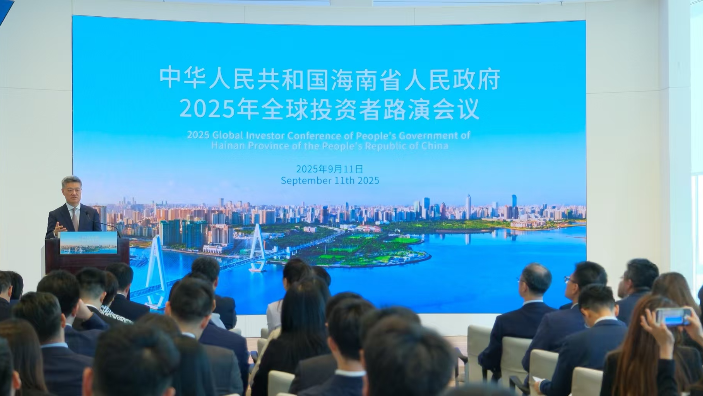By continuing to browser our site and use the services you agree to our use of cookies, Privacy Policy and Terms of Use. You can change your cookie settings through your browser.
The International Media Center of hinews.cn undertakes the mission of news, culture and education communication. Hinews.cn will launch bilingual articles on Hainan's human geography in both Chinese and English. Stay tuned for further update.
“Venturing to Nanyang (Southeast Asia)" was once a unique cultural phenomenon in the eastern part of Hainan Island. It is an epitome of Hainan people who have opened up a new living space, participated in the tide of world economy and culture, and finally returned to their hometown as well reciprocated the hometown. It is also a vivid epitome of the development and changes in modern Hainan, even in China. It has reflected Hainan people’s fighting spirit of continuously venturing to Nanyang and continuously making new achievements in Southeast Asia in the past 100 years, which is full of distinctive island culture features.
-----------------------------------------------------------------------------------
Data Comparison

In Hainan, three cities with large population venturing to Nanyang (Southeast Asia) are Wenchang, Qionghai and Wanning, of which Wenchang tops the list.
Why did Wenchang have the largest number of people venturing to Nanyang? It can be evidenced by data.
In recent years, authoritative departments have carried out such statistics:
There are a large number of overseas Chinese from Wenchang, with about 1.2 million people in more than 50 countries and regions in the world. They mainly live in Southeast Asian countries, such as Thailand (about 500,000), Malaysia (about 350,000), Singapore (about 110,000) and Vietnam (about 150,000). There are about 380,000 returned overseas Chinese and their families in Wenchang (the population of Wenchang is about 570,000, thus, population of overseas Chinese is twice as large as Wenchang residents). In Wenchang, few people there has no overseas relations. Wenchang enjoys the reputation of “the hometown of overseas Chinese” in Hainan, and is also one of the most famous hometowns of overseas Chinese in China.

There are about 550,000 overseas Chinese and compatriots from Hong Kong, Macao and Taiwan of Qionghai origin, distributing in 28 countries and regions around the world. And about 90% are distributed in Southeast Asian countries, such as Singapore, Malaysia, Indonesia and Thailand.
Wanning has more than 300,000 overseas Chinese and compatriots from Hong Kong and Macao, which distribute in 26 countries and regions. And there are nearly 200,000 returned overseas Chinese and their family. Thus, Wanning is rich in the resources of overseas Chinese.
Data comparison among these three cities: 1.2 million, 550,000 and 300,000 respectively. The number “550,000” of Qionghai and “300,000” of Wanning both include the number of compatriots from Hong Kong and Macao; while 1.2 million of Wenchang only refers to overseas Chinese. It is thus clear that, Wenchang has the largest number of overseas Chinese in Hainan.
Why did Wenchang have the largest population venturing to Nanyang?
In Hainan, why did Wenchang have the largest number of people venturing to Nanyang?At least for the following reasons:
First, Wenchang has a large population but limited land. Fu Zhongqun, chairman of Wenchang Writers Association, said that Wenchang has limited per capita land, and many fields have more sand than normal soil, fresh water resource is in short supply as well. Before the Liberation, Wenchang did not have a good irrigation system, in addition to sandy soil, fields were often short of water due to irrigation problems. Thus, the people were already satisfied as long as normal living and drinking water supply can be guaranteed.
Besides, Wenchang were always attacked by strong typhoons for many years, causing the low output of crops. Farming basically depends on weather there. People all lived a difficult life and had to find other ways to survive and make a living. After the Qing government abolished the sea ban, in order to make a living, many young people boarded on sailboats at Qinglan dock in Qinglan port to cross the sea heading for the Southeast Asia to fight for life, and then sent money back to support their families. Such phenomenon is called “going to Fan (foreign countries)” or “venturing to Nanyang (Southeast Asia)”. Villages called "Fanke village" are everywhere in their hometown. Later, more and more people in Wenchang went to work abroad to make a living. Up to now, the number of overseas Chinese living abroad is much larger than the local population. Therefore, Wenchang is given the name of the hometown of overseas Chinese.
Tan Xianbo, a writer from Wenchang, has published a novel "Women in Fanke Village", which vividly and concretely described the sufferings and pains of women in Fanke Village. For women who lived alone and looked after their families in Fanke Village, he wrote down these weepy stories which are full of scenes of sorrow, joy, separation and reunion.
In fact, it is difficult to generalize where the land in Hainan is barren or fertile, but it can be tested whether a place is suitable for a certain plant. For example, Qionghai is suitable for planting pepper, betel nut and rubber; Ding'an is suitable for planting peanuts, and Dongfang City is suitable for planting rose wood; the coconut forest in the eastern suburb of Wenchang can appear on stamps, which shows that Wenchang is suitable for planting coconut trees.
Lin Mingqi, director of the Village Committee of Dajia Village, Dongge Town, Wenchang, told me that a company once wanted to find the field which is the most suitable for planting fragrant rice. They searched all over Hainan Island, but fields in many cities and counties all had defects. Fortunately, they finally found the suitable field at Dongge in Wenchang. In fact, some fields in Wenchang are rich in selenium without any pollution. So high-end rice can be planted and produced on a large scale there. But this kind of rice requires a lot of organic fertilizer. It also has obvious advantages that the price of high-end rice is high and it can be fully underwritten once harvested. Looking at Wenchang today, Fu Zhongqun believes that although it has a large population but little land, efficient agriculture is a new way deserving to explore.
Second, life was turbulent. From 1926 to 1930, due to the chaos of governance in Fujian and Guangdong Province, the civil war spread, people's activities were uneasy, and many young Hainanese fled to the Southeast Asia to find a new life.
Third, foreign ships often traded in Guangzhou, Qiongshan, Leizhou and other ports at that time. Most of ships came from Stag-gzig (now Arabia) and Srivijaya (now Indonesia), which enabled Wenchang people living in the east of the island to travel to Southeast Asia with the advantage of the shipping routes. Then they became the earliest "Zhufan (foreign residents)", and their descendants became the "native Tang people".
Fourth, Wenchang has relatively calm ports of Puqian and Qinglan, providing good conditions for travelers. Most Wenchang people started from the Puqian Port and Qinglan Port, and then headed for all parts of Southeast Asia. They usually set off around the winter solstice on barkentines, taking advantage of the north wind and drifting along the current for about a month. Finally, they would arrive in Southeast Asian countries, including Vietnam, Thailand, Malaysia, and Singapore.

According to relevant statistics, from 1876 to 1898, the number of Hainan overseas Chinese who went abroad through the port had reached 247,700, with an average of more than 10,000 per year. And it could be up to a maximum of more than 20,000 some year. Wenchang people accounted for more than a half of this figure, and they almost were young labor force.
Fifth, Wenchang people took advantage of Haikou's good geographical location. Now we talk about the integration of Haikou, Chengmai and Wenchang. Historically, Wenchang and Haikou had already merged in some aspects. For example, it was very convenient for people exchanges and many Wenchang people set off from Haikou to Southeast Asia. From 1902 to 1911, Haikou already had ships sailing to Bangkok, Singapore and other ports, with two or three departures a month in spring and summer. Each time those ships could take more than 1,000 people at most, or 300 to 600 people at least. Of course, Wenchang people was still the majority of them.
Sixth, during the Anti-Japanese War, a large number of Wenchang overseas Chinese took their families and relatives, risking their lives to take masted boats on Qinglan, Puqian, Baoling, Fengjia, and Wulong ports. They broke through the Japanese blockade, crossed the Qiongzhou Strait, took refuge in Chikan and Xixia (now Zhanjiang, the French concession at that time) in Guangzhou Bay, and then took boats to various ports in Southeast Asia to find their relatives and make a living.
According to the customs statistics, the number of overseas Chinese from Hainan increased from 33,000 in 1936 to more than 44,000 in 1937. In 1939, the number of Hainan overseas Chinese reached its peak. The number of people who fled to Guangzhou Bay "nearly reached 50,000". Then, with the aid of the Hainan Overseas Chinese Federation, most of them moved to Singapore, Malaysia, Thailand and other places.
During the Anti-Japanese War, Wenchang people also opened up land routes to Southeast Asia, mainly going to Vietnam via Guangxi province, or to Myanmar via Yunnan province.
In order to promote friendship, help each other and seek common welfare, the early Wenchang overseas Chinese who made a living in a foreign country, established different forms of social organizations. Geographically, there were temples, shrines, guild halls, clubs, and fellow provincials associations. In Singapore, there are more than 20 geographical organizations and fellow townsmen associations. Wang Shaojing and Wang Xiande, leaders of overseas Chinese from Qionghai, have served successively as the chairman of Qiongzhou Guild Hall. The consanguineous groups take kinship as the tie and clan as the unit. There are more than 30 such groups in Singapore and Malaysia, such as Fu's Clan and Qiongya Huang's Clan. Industry-related groups mostly take industry as the unit to organize associations, aiming at helping each other among fellow townsmen.
The early Wenchang people firstly find a footfold in Southeast Asia, and then helped their townsmen later on, giving Wenchang people an advantage of venturing Southeast Asia.
FTP Expert Talks | Xiaodong Lee, Vice President of the Internet Society of China and Founder of the Fuxi Institution: Hainan is the "Nebula" of New Digital Youth
09:47, 12-September-2025Hainan Issues Offshore RMB Bonds in HK for 4th Consecutive Year
09:46, 12-September-20252025 Hainan FTP International Students Content Creation Project
02:28, 12-September-2025What Makes "Hainan Travel" So Appealing?
09:38, 11-September-2025100 Days to Go: What's Next for Hainan-Hong Kong Cooperation?
09:38, 11-September-2025Expert Talks Ep. 4: The Future of the FTP's Digital Economy
09:35, 11-September-2025By continuing to browser our site and use the services you agree to our use of cookies, Privacy Policy and Terms of Use. You can change your cookie settings through your browser.





